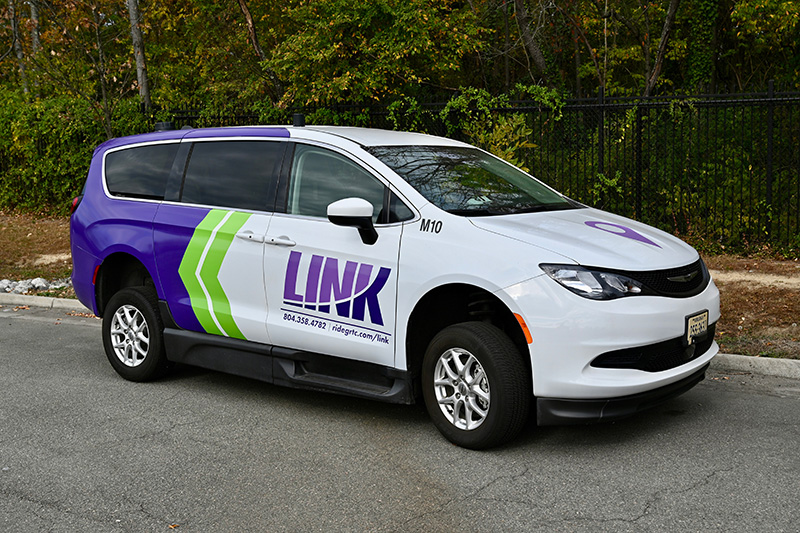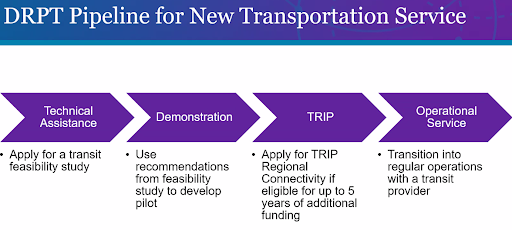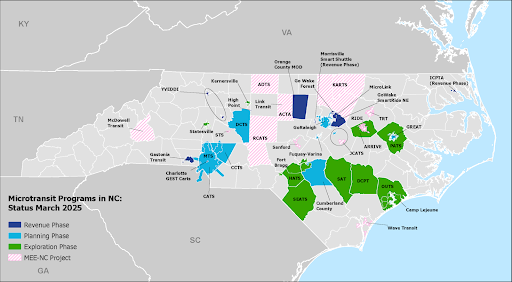Transit Innovation Workshop Series Workshop #4: More Ways to Move: Using Microtransit to Connect Communities
15 minutes Author: Shared-Use Mobility Center Date Launched/Enacted: May 22, 2025 Date Published: May 22, 2025

Introduction
The American Association of State Highway and Transportation Officials (AASHTO) and the Shared-Use Mobility Center (SUMC) hosted the fourth and final virtual workshop of a series focusing on how State Departments of Transportation (DOTs) support mobility innovation. The workshops were designed to build upon each other and explore topics like data standards, trip planning apps, and multimodal payment solutions.
Over 50 practitioners from State DOTs, technical assistance centers, and other organizations involved in this space joined this last session to discuss how State DOTs support local communities leveraging microtransit and smaller demand-responsive transit services, particularly serving small towns and rural areas. Following introductions from AASHTO and SUMC highlighting the importance of collaboration within and across states, the workshop highlighted the work of two DOTs with presentations by:
- Brennon Fuqua, Director, Integrated Mobility Division, North Carolina Department of Transportation (NCDOT)
- Tiffany Dubinsky, Director of Transit Planning, Virginia Department of Rail and Public Transportation (DRPT)
The virtual workshop concluded with a Questions & Answers discussion.
Definitions
- Mobility as a Service (MaaS): A suite of mobility services, usually across several modes, that also allows trip-planning, reservations, ticketing and payment via a single application. MaaS integrates various forms of transportation and transportation-related amenities into a single, comprehensive service.
- Mobility on-Demand (MOD) is a vision for an integrated multimodal network of safe, carefree, and reliable transportation options that are available to all for personal mobility and goods delivery. MOD envisions flexible mobility options, available either in advance or immediately, for users to seamlessly and easily get around.
- Microtransit: A technology-enabled service that uses multi-passenger vehicles (usually small transit vehicles) to provide on-demand transit with dynamically generated routing, generally provided in designated service areas. Different service configurations can provide connections to fixed-route transit from harder to serve areas, as well as local circulator services that don’t require additional connections.
Major Takeaways
State DOTs have an interest in investing in microtransit
State DOTs are adopting various strategies to support on-demand microtransit services to increase access to transportation, particularly for small towns and rural communities. State DOTs are supporting these efforts through state-managed programs, such as Virginia’s special programs that focus on MaaS, MOD, and microtransit from feasibility and planning studies, through demonstration projects.
Coordination between partners is essential
Strong coordination between transit providers, local governments, planning organizations, and other relevant agencies is essential for developing successful projects. NCDOT found that a lack of effective coordination between players, and specifically with municipalities, can slow down critical conversations on funding. It is crucial to engage partners from the beginning to ensure smooth collaboration.
Take a structured approach to implementation
States can develop a structured approach or pipeline for implementing microtransit, starting with planning or feasibility studies to determine the service model and define service scope and costs. This can be followed by demonstration or pilot projects, often supported by state or discretionary grants, to evaluate the project. Virginia DRPT utilized this approach by guiding agencies from technical assistance for planning and feasibility studies to applying for demonstration grants. DRPT’s efforts also focused on building demand and creating data to support a successful transition of services to regular operations.

DRPT Pipeline for New Transportation Service. Credit: DRPT
Invest in post-program research
States can benefit from partnering with universities on post program research, as they can provide the analytical capacity needed to evaluate and understand crucial aspects of operation. NCDOT is collaborating with the Institute of Transportation, Research and Education at North Carolina State University on a research program to study the implementation, ridership modal changes, and fare impacts using data collected from the state’s demonstration projects.
Procurement of unfamiliar services and technologies can present new challenges
The procurement process for new technology that enables microtransit services can be particularly challenging for states, as many are unfamiliar with the process and face additional internal departmental hurdles. States can consider strategies to better manage procurement challenges, such as developing standardized procurement templates to support a streamlined process or utilizing consulting assistance to ensure vendors understand specific agency needs.
Presentation Overviews
Tiffany Dubinsky, Virginia Department of Rail and Public Transit (DRPT)
 Tiffany Dubinsky, Director of Transit Planning at the Virginia Department of Rail and Public Transit (DRPT), presented on Virginia’s efforts to support mobility solutions, highlighting a strong focus on microtransit. DRPT is a sister agency to the Virginia DOT and manages several state funding, workforce development, and technical assistance programs to help localities plan, design, and implement mobility projects.
Tiffany Dubinsky, Director of Transit Planning at the Virginia Department of Rail and Public Transit (DRPT), presented on Virginia’s efforts to support mobility solutions, highlighting a strong focus on microtransit. DRPT is a sister agency to the Virginia DOT and manages several state funding, workforce development, and technical assistance programs to help localities plan, design, and implement mobility projects.
Dubinsky highlighted a number of statewide programs administered by DRPT that support local agencies in implementing microtransit projects, including DRPT’s Demonstration Project Assistance and Transit Ridership Incentive Program (TRIP). The Demonstration Project Assistance program is a competitive grant program that funds the implementation of non-traditional public transportation solutions. This program helps agencies test proofs of concept for innovative services, which when effective, can then serve as examples for replication for other agencies.
DRPT’s TRIP program aims to promote regional connectivity, specifically for low-income populations. TRIP was created in 2020 and supports demonstration projects that fit four different categories: regional connectivity, zero-fare and low-income, passenger amenities and facilities, and crime prevention and public safety. DRPT’s process in supporting new transportation projects through TRIP begins with technical assistance and transit feasibility studies. Cities and agencies can work with DRPT and use recommendations from feasibility studies to develop a pilot program. TRIP then helps fund eligible pilots for up to 5 additional years, supporting their transition into regular operations.
These programs supported various microtransit deployments in Virginia, including MicroCAT in Albemarle County, GLTC Flex in Lynchburg, and GRTC Link in Richmond.
DRPT also launched the Virginia Rural Microtransit Deployment Initiative, with support from a Federal Transit Administration Integrated Mobility Innovation (IMI) grant and Virginia’s Innovation Technology Transportation Fund (ITTF). This initiative aimed to understand how microtransit solutions can be scaled and deployed effectively to meet the mobility needs of rural communities throughout the state, particularly within frameworks of existing transit services. The Virginia Rural Microtransit Deployment Initiative supported two projects: Bay Area Transit Express, a demand response service with deviated fixed-route lines in Eastern Virginia and METGo!, a zero-fare service operated by Mountain Empire Older Citizens in rural Western Virginia.
Additionally, the presentation highlighted resources and tools developed by DRPT to further support transit agencies within Virginia in implementing microtransit services. The Rural Microtransit Case Study and Report is an evaluation of the Virginia Rural Microtransit Deployment Initiative, and contains an operational sustainability strategy as well as a rural microtransit suitability checklist and implementation toolkit. DRPT’s Rural Transit Technology Toolkit focuses on technology procurement for microtransit technology and automated scheduling systems.
DRPT’s technical assistance initiatives, grant programs, and resource development demonstrate the active role states can play in supporting microtransit and other innovative local and regional transportation services.
Brennon Fuqua, North Carolina Department of Transportation (NCDOT)
 Brennon Fuqua, Director of NCDOT’s Integrated Mobility Division, presented on North Carolina’s support for microtransit, highlighting the technical assistance provided to rural transit agencies. NCDOT views microtransit as a valuable complement to the state’s multimodal network, providing critical connections to other modes of transportation, especially in rural, low density areas, which constitute the vast majority of the state.
Brennon Fuqua, Director of NCDOT’s Integrated Mobility Division, presented on North Carolina’s support for microtransit, highlighting the technical assistance provided to rural transit agencies. NCDOT views microtransit as a valuable complement to the state’s multimodal network, providing critical connections to other modes of transportation, especially in rural, low density areas, which constitute the vast majority of the state.
NCDOT’s Integrated Mobility Division dedicates time to supporting transit agencies and local governments in understanding the various microtransit service delivery models. By outlining implementation processes and explaining the benefits and challenges of each approach, agencies can make decisions regarding expansion and service improvements that align with their long term plans and goals.
State DOTs should consider key factors when implementing microtransit. For NCDOT, important considerations include understanding funding options, leveraging discretionary grants, and identifying sustainable funding sources from local, state, or third-party partners. Additionally, ensuring transit agencies have access to their own data for program monitoring, conducting thorough vendor searches, developing fare determination strategies, and fostering strong coordination among partners are essential. State agencies can support local partners and help build capacity.
Currently, NCDOT is working to incorporate these considerations into the Mobility for Everyone Everywhere (MEE) program, a rural transportation initiative focused on the capital needs of microtransit operations such as turnkey services or software purchases to support facilitation of operations for transit agencies. The program supports 11 communities, including 9 that are new to public transit, in launching on-demand transit services to improve access to opportunities, services, and resources.
Microtransit services have seen significant growth in the state, starting with two deployments in 2020 in Orange County and the City of Wilson, and have increased to 11 agencies by 2024. The number of revenue generating microtransit agencies is expected to increase to 21 by the end of 2025. NCDOT is also planning a follow-through research program in partnership with North Carolina State University’s Institute for Transportation Research and Education (ITRE) to evaluate implementation, ridership changes and fare impacts using data from MEE projects to build a framework for future microtransit efforts.

Credit: NCDOT
Conclusion
State DOTs are exploring microtransit solutions to expand access for smaller communities and rural areas and to support innovation and new technology in public transportation. Microtransit offers flexible and convenient on-demand transportation services that are well-suited for providing access in rural and low density areas where traditional transit may be less effective. These services can act as vital connections, providing first/last mile links to fixed routes or replacing traditional services in select areas. State DOTs are assisting local agencies interested in microtransit by offering technical assistance and other programs that provide a pipeline from planning to demonstration and into regular operations. These efforts demonstrate the potential to increase transit ridership and support the needs of residents without personal vehicles, and these pilot projects can create valuable data that can be utilized to evaluate services and inform future transit planning and policy decisions.